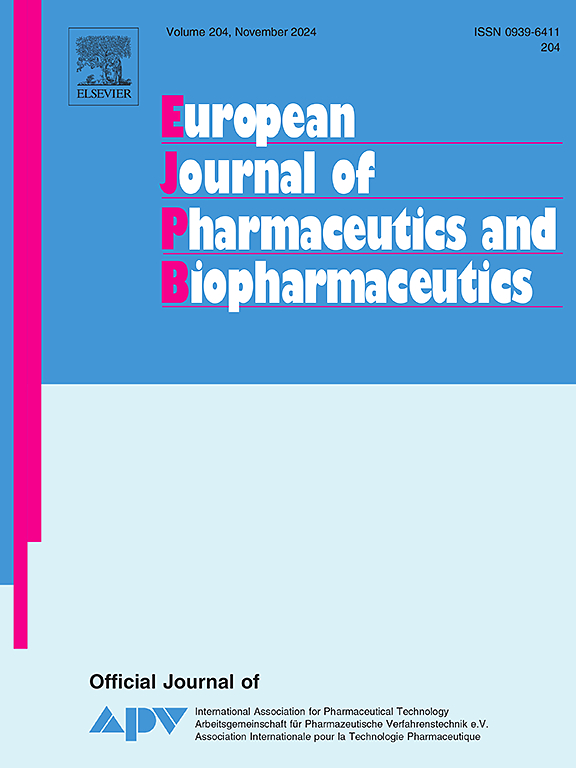Rational design of PLA-based ASDs for pharmaceutical 3D printing: Insights from phase diagram modeling
IF 4.4
2区 医学
Q1 PHARMACOLOGY & PHARMACY
European Journal of Pharmaceutics and Biopharmaceutics
Pub Date : 2025-02-05
DOI:10.1016/j.ejpb.2025.114657
引用次数: 0
Abstract
The integration of 3D printing into the pharmaceutical sciences opens new possibilities for personalized medicine. Poly(lactide) (PLA), a biodegradable and biocompatible polymer, is highly suitable for biomedical applications, particularly in the context of 3D printing. However, its processability often requires the addition of plasticizers. This study investigates the use of phase diagram modeling as a tool to guide the rational selection of plasticizers and to assess their impact on the thermodynamic and kinetic stability of PLA-based amorphous solid dispersions (ASDs) containing active pharmaceutical ingredients (APIs). Thermodynamic stability against API recrystallization was predicted based on the API solubility in PLA and Plasticizer-PLA carriers using the Conductor-like Screening Model for Real Solvents (COSMO-RS), while the kinetic stability of the ASDs was evaluated by modeling the glass transition temperatures of the mixtures. Two APIs, indomethacin (IND) and naproxen (NAP), with differing glass-forming abilities (i.e., recrystallization tendencies), and three plasticizers, triacetin (TA), triethyl citrate (TEC), and poly(L-lactide-co-caprolactone) (PLCL), were selected for investigation. The physical stability of ASD formulations containing 9 wt% API and plasticizer to PLA in two ratios, 10:81 and 20:71 w/w %, was monitored over time using differential scanning calorimetry and X-ray powder diffraction and compared with phase diagram predictions. All formulations were predicted to be thermodynamically unstable; however, those containing no plasticizer or with TEC and TA at 10 wt% were predicted to exhibit some degree of kinetic stability. Long-term physical studies corroborated these predictions. The correlation between the predicted phase behavior and long-term physical stability highlights the potential of phase diagram modeling as a tool for the rational design of ASDs in pharmaceutical 3D printing.

基于pla的药物3D打印asd的合理设计:来自相图建模的见解
3D打印与制药科学的结合为个性化医疗开辟了新的可能性。聚(丙交酯)(PLA)是一种可生物降解和生物相容性聚合物,非常适合生物医学应用,特别是在3D打印的背景下。然而,其加工性往往需要添加增塑剂。本研究利用相图建模作为工具来指导增塑剂的合理选择,并评估它们对含有活性药物成分(api)的pla基非晶固体分散体(ASDs)的热力学和动力学稳定性的影响。基于API在PLA和增塑剂-PLA载体中的溶解度,使用真实溶剂类导体筛选模型(cosmoo - rs)预测了API再结晶的热力学稳定性,而通过模拟混合物的玻璃化转变温度来评估asd的动力学稳定性。选择两种具有不同玻璃形成能力(即再结晶倾向)的原料药吲哚美辛(IND)和萘普生(NAP),以及三乙酸酯(TA)、柠檬酸三乙酯(TEC)和聚l -乳酸-co-己内酯(PLCL)三种增塑剂进行研究。采用差示扫描量热法和x射线粉末衍射法监测了含有9 wt% API和增塑剂与PLA的两种比例(10:81和20:71 w/w %)的ASD配方的物理稳定性,并与相图预测结果进行了比较。预测所有配方都是热力学不稳定的;然而,那些不含增塑剂或TEC和TA在10 wt%预计表现出一定程度的动力学稳定性。长期的物理研究证实了这些预测。预测相行为与长期物理稳定性之间的相关性突出了相图建模作为药物3D打印中asd合理设计工具的潜力。
本文章由计算机程序翻译,如有差异,请以英文原文为准。
求助全文
约1分钟内获得全文
求助全文
来源期刊
CiteScore
8.80
自引率
4.10%
发文量
211
审稿时长
36 days
期刊介绍:
The European Journal of Pharmaceutics and Biopharmaceutics provides a medium for the publication of novel, innovative and hypothesis-driven research from the areas of Pharmaceutics and Biopharmaceutics.
Topics covered include for example:
Design and development of drug delivery systems for pharmaceuticals and biopharmaceuticals (small molecules, proteins, nucleic acids)
Aspects of manufacturing process design
Biomedical aspects of drug product design
Strategies and formulations for controlled drug transport across biological barriers
Physicochemical aspects of drug product development
Novel excipients for drug product design
Drug delivery and controlled release systems for systemic and local applications
Nanomaterials for therapeutic and diagnostic purposes
Advanced therapy medicinal products
Medical devices supporting a distinct pharmacological effect.

 求助内容:
求助内容: 应助结果提醒方式:
应助结果提醒方式:


